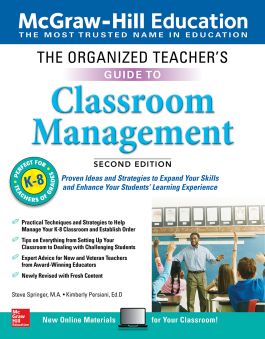The Organized Teacher's Guide to Classroom Management, Grades K-8, Second Edition
Step 1. Download Adobe Digital Editions Both PC and Mac users will need to download Adobe Digital Editions to access their eBook. You can download Adobe Digital Editions at Adobe's website here.
Step 2. Register an Adobe ID if you do not already have one. (This step is optional, but allows you to open the file on multiple devices) Visit account.Adobe.com to register your Adobe account.
Step 3: Authorize Adobe Digital Editions using your Adobe ID. In Adobe Digital Editions, go to the Help menu. Choose “Authorize Computer.”
Step 4: Open your file with Adobe Digital Editions. Once you’ve linked your Adobe Digital Editions with your Adobe ID, you should be able to access your eBook on any device which supports Adobe Digital Editions and is authorized with your ID. If your eBook does not open in Adobe Digital Editions upon download, please contact customer service
Preface
1 Theorists
Twelve Theorists of Classroom Management
Albert Bandura: Social Learning Theory
Lee and Marlene Canter: Assertive Discipline
Richard Curwin and Allen Mendler: Discipline with Dignity
Rudolf Dreikurs: Discipline Through Democratic Teaching
Haim Ginott: Discipline Through Congruent Communication
William Glasser: Noncoercive Discipline
Fred Jones: Positive Classroom Discipline
Spencer Kagan: Win-Win Discipline
Jacob Kounin: Improving Discipline Through Lesson Management
Marvin Marshall: Discipline Through Raising Responsibility
Fritz Redl and William Wattenberg: Discipline Through Influencing Group Behavior
B. F. Skinner: Discipline Through Shaping Desired Behavior
2 Organizing Your Classroom
Physical Arrangement
Purposeful Room Arrangement
Inheriting a Classroom
High-Traffic Areas
Student Accessibility to Teacher and Instruction
Teacher and Student Supply Kits
Teacher Kit
Student Kits
Bulletin Boards
Physical Classroom Setup
Instructional Focal Point
Arrangement of Student Desks
Placement of Teacher’s Desk
File Cabinets
Equipment
Bookcases
Small Group Instruction Areas
Learning Centers/Labs
Textbooks
Instructional Materials
Student Work and Student Portfolios
Utilizing Storage Space
Efficiency Is the Key
3 Establishing Rules, Consequences, and Procedures
Establishing Classroom Rules
Kindergarten–First Grade
Second–Third Grades
Fourth–Sixth Grades
Secondary Grades or Advanced Learners
Rules That Work for Any Grade
Additional Ideas for Rules
Establishing Classroom Consequences
Time-Out
Detention
Communication Home
Action Plan and/or Conference
Summary
Establishing Classroom Procedures
Use of Classroom Elements
Student Participation
Talking Among Students
Obtaining Help
Activities for “Early Finishers”
Classroom Transitions
General Procedures
Distributing Materials
Interruptions and Delays
Restroom Breaks
The Library
The Resource Room
The Office
The Nurse
The Cafeteria
The Playground and Equipment
Fire and Disaster Drills
Classroom Helpers and Monitors
4 Managing Student Behavior
Consistency
A Positive Classroom Climate
Incentives and Rewards
Recognition
Privileges
Activities
Tangible Rewards
Cautions About Using Rewards
Managing Misbehavior
Misbehavior in the Classroom
Identifying Misbehavior
Discipline and Flexibility
Converting Inappropriate Behavior
Techniques for Managing Behavior
Anecdotal Records
Addressing Concerns About Behavior
Meeting the Students’ Needs
Communicating with Parents
5 Getting off to a Good Start
Teaching Routines and Procedures
Describing and Modeling Desired Behavior
Students Respond to Appropriate Classroom Routines
Give Appropriate Feedback
Creating a Congenial and Positive Climate in Your Classroom
Teacher Authority
Rules and Consequences
The First Days of the School Year
Communicating with Families
Anticipating Problems
The First Week of School
Final Thoughts
6 Know Your Support Team
Connecting with the Team
Members of the Team
Teachers
Administration
Office Staff
Instructional Support
Parents
7 Planning, Instruction, and Assessment
Planning
Common Core Standards
Goals
Objectives
Materials
Lesson Plan Procedures
Instruction
Tone
Strategies
Inclusion
Questioning
Assessment
Summative Assessment
Formative Assessment
Check for Understanding
Reflection
Aids for Planning, Instruction, and Assessment
Troubleshooting a Lesson
Lesson Plan Templates
5E Lesson Plan
Student-Focused Lesson Plan
Understanding Your Teacher’s Edition
Cumulative Records
Individualized Education Plan
Bloom’s Taxonomy
Gardner’s Multiple Intelligences
Visual, Auditory, and Kinesthetic Learning Styles
Final Thoughts
8 Managing Active Learning
Group Work
Designing Small Groups
Activities for Small Groups
Activity for Pairs or Partners
Learning Centers
Setting Up Learning Centers
Curriculum-Related Learning Centers
Learning Center Rules of Behavior
Individual Work
Activities for Individual Work
Final Thoughts
9 Instructional Challenges
Different Learning Styles
Visual Learners
Auditory Learners
Kinesthetic Learners
Modifications
Getting Students Started
Keeping Students Engaged
Keeping Students in Their Seats
Helping Students Follow Directions
Additional Modifications
Working with Students with Special Needs
Students with Learning Disabilities
Students with ADD or ADHD
Students with Autism
Students with Asperger’s Syndrome
Students with Emotional and Behavioral Disorders
Students Who Are Gifted
Working with English Language Learners
E.L.D. Levels
E.L.D. Strategies
E.L.D. Series
English Language Development Levels
Diversity of Students
Diversity and the Curriculum
Final Thoughts
10 Curriculum Overview
Understanding Who Your Students Are
Kindergarten (5–6 Years Old)
First Grade (6–7 Years Old)
Second Grade (7–8 Years Old)
Third Grade (8–9 Years Old)
Fourth Grade (9–10 Years Old)
Fifth Grade (10–11 Years Old)
Sixth Grade (11–12 Years Old)
Understanding the Curriculum
Language Arts: Reading
Language Arts: Writing
Math
Social Studies
Science
Physical Education
Visual and Performing Arts
Cross-Curricular Subject Areas
Curriculum Planning
Templates
Index
Classroom management can be challenging even for experienced teachers. Written by two award-winning educators, this practical guide is filled with tips and proticols to help you manage your classroom more efficiently. There’s advice on setting up your classroom, establishing rules, dealing with difficult students, meeting with parents, and much more. The authors also examine teaching theories from leading educators and offer guidance to help you determine the best teaching style for every situation.
The book includes dozens of useful documents such as charts, rewards certificates, child-teacher or parent-teacher contracts for homework, attendance or discipline, and more. The documents can also be accessed online and sent directly to a printer, saving you valuable time.
The Organized Teacher’s Guide to Classroom Management, Second Edition will help you:
• Find strategies to keep your classroom running smoothly• Determine which teaching style is most appropriate for you• Establish rules, consequences, and procedures• Manage student behavior in the classroom• Create more inspired lesson plans and curricula• Get organized with reproducible charts, checklists, and more

